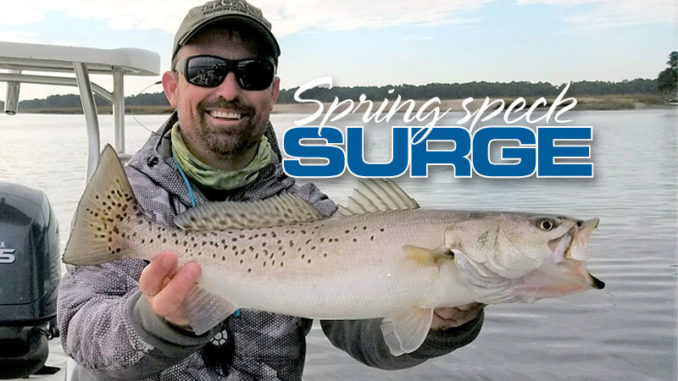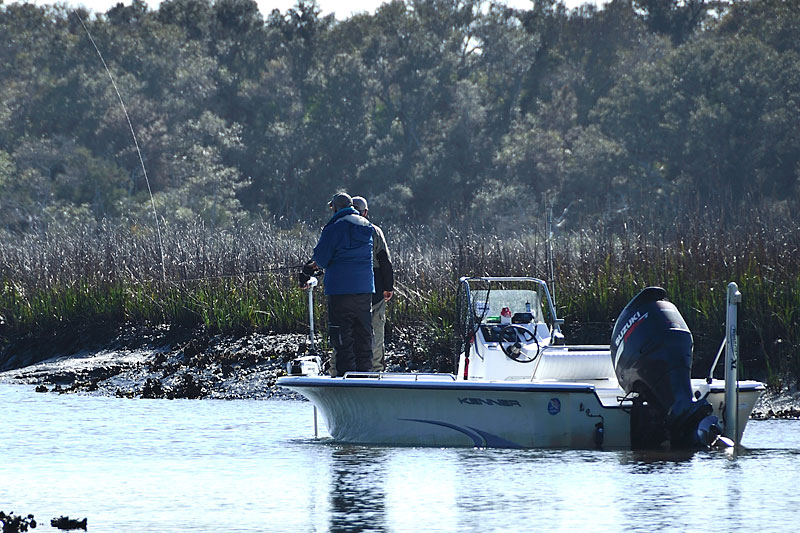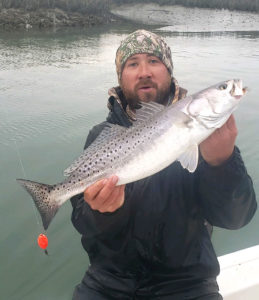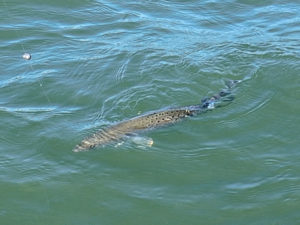
Spring brings big speckled trout bite to Carolina anglers
Spring arrives early for Carolina anglers. And after another relatively mild winter, the spring speckled trout fishing in the coming weeks is expected to produce solid results.
Specks have an opportunity to take a ride back to the dock during any month. But fall and spring rank high on the list. Many Carolina anglers concentrate on the fall bite. But the spring season can be epic if they choose their locations wisely and incorporate a game-winning strategy.
From 1,000-pound tiger sharks lurking offshore to doormat flounder patrolling the docks along the Atlantic Intracoastal Waterway, saltwater fish are truly free. They can travel just about anywhere they please. They migrate throughout their range as environmental conditions change with the seasons. Some practically travel the globe each year. Others travel in a much smaller circle to take advantage of water conditions and feeding opportunities.
Speckled trout migrate up and down the Eastern Seaboard, in and out of inlets and estuaries, throughout the year.

Carolina waters hold trout year-round
The inshore waters along the coast of the Carolinas will typically have speckled trout around every month. Water temperature and food availability are driving factors that shape their movements. And spring can offer prime water temperatures and plenty of available forage for a good chance to limit out on specks.
Dan Connelly of O-Fish-Al Expeditions is locally known as the “official fish whisperer” of Murrells Inlet, S.C. And speckled trout are one of his specialties, offering strong, consistent spring action.
“As we creep into spring, we start catching trout regularly again, back in the creeks,” said Connelly (843-241-7022). “We find more and bigger trout chasing mullet around in the creeks.”
Typically, glass minnows, pinfish, croakers, menhaden and finger mullet migrate out of the creeks and estuaries into the ocean as the water temperature drops in the fall. Carolina estuaries will often retain a small population of mullet to feed the local fleet of overwintering redfish and speckled trout. As the water begins to warm in spring, the local mullet population feels the heat and becomes more active. And the speckled trout also wake up and begin putting heat on the mullet.
Even though conditions are shaping up, mullet aren’t widespread. So anglers must go into seek-and-search mode. Connelly tries to find creeks that are loaded with bait; when he does, he’s found his next place to fish.
Spend some time observing at low tide
“In the spring, I like to go out at low tide and check these creeks out with my trolling motor,” he said. “The water is typically clear, and you can see the concentrations of bait back in these creeks. I don’t always see trout in these creeks, but the bait will tell the story.”
Trout will typically stage in deeper pockets back in these creeks and ambush bait as it passes by. Connelly takes note of these hotspots and will return on higher water.
“I prefer to fish these shallow creeks on higher water when the fish are less skittish,” he said.
Connelly prefers to fish on each side of the peak of the high tide during spring because the fish are less spooky and the water will be a few degrees cooler. When spring weather arrives, the water in the creeks will heat up significantly. But the ocean water remains in the 50s, right where the trout like it.
Even though speckled trout are concentrating on mullet, Connelly will use live shrimp, if available.
“Shrimp aren’t available this time of year in the creeks. But a speckled trout will not pass up a live shrimp, either,” he said. “If we can get them at the bait shop, we will either float them under a cork or put them on a hook behind a small split shot and let them swing in the current.”
If live shrimp aren’t available, Connelly will use an artificial shrimp, Z-Man paddletail or other soft-plastic jerk shad. A slow technique will produce a strike.

Go slow this time of year for best results
“Mullet are typically still moving relatively slow, and a slow-and-go retrieve works well,” he said. “I use a very slow crawl retrieve. I cast and let sink to the bottom, do a twitch-twitch and let it fall. The slower the better.”
Connelly typically targets interior creeks when the water is higher. But when his trips wind up on the low end of the tide, he will fish in the receiving creeks and around the mouths to these smaller creeks.
“When the tide is lower, I will be fishing the deeper areas outside these shallow creeks. The fish will fall back to these spots on unusually low water,” he said.
While there are sufficient schools of trout available in March, they are not as widespread as in the fall. Trout will move from one place to the next chasing bait in and out of creeks. When the trout seem to have vanished, Connelly will slow-troll jigs along the main creeks and feeder creeks on higher water to find pods of fish.
“When it gets warmer, I will slow-troll paddletails in the main creeks like Oaks Creek in Murrells Inlet,” he said. “I like to use a ½-ounce jighead to keep the jig down near the bottom and slow-troll against the current at one to two miles per hour. As soon as we get bit, we will stop and start casting.”
The spring speckled trout bite can be fast and furious. Find the bait and the trout will be right on their tails.
Try fresh-cut mullet
Speckled trout typically forage on lively, swimming fish and shrimp. But the lack of significant forage in the spring will entice a big speckled trout to gobble up a chunk of freshly cut mullet.

Dan Connelly of O-Fish-Al Expeditions has live shrimp and soft plastics among his staple spring trout baits, but he will fish a chunk of mullet for good reason.
“I have caught two of my personal best trout on fresh-cut mullet in the spring,” Connelly said, “but they must be super fresh. I catch them and cut them up immediately. They can’t resist a big chunk of fresh mullet. They will eat it up!”
Mullet can easily be caught with a cast net and kept alive in a livewell. Speckled trout are typically eating mullet this time of year, and a chunk of fresh mullet is an easy meal for them. The large, gator trout primarily eat mullet throughout the year, and a big chunk of their favorite food dropped in front of them is tough to resist. A chunk of fresh mullet will also get attention from any redfish and flounder in the area, too.
Cut mullet may not be the primary bait choice for speckled trout the rest of the year, but spring is definitely a good time to toss it out into troubled waters to see what is lurking.





Be the first to comment